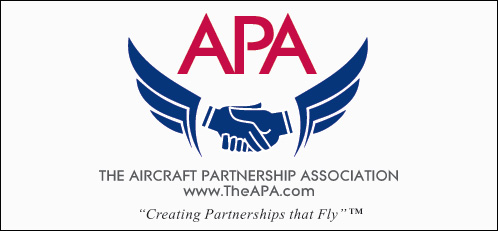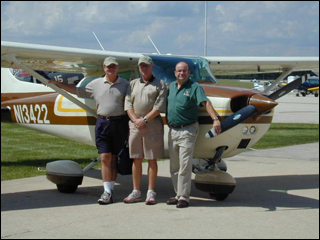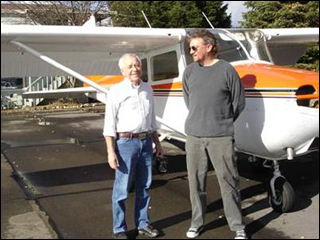This eFLYER was developed in HTML for viewing with Microsoft Internet Explorer while connected to the Internet: View Online.
To ensure delivery to your inbox, please add eFLYER@barnstormers.com to your address book or list of approved senders. |
 |
ISSUE
19 - June 2008
Over 6,000 Total Ads Listed
700 NEW Ads Per Week |
| AIRCRAFT PARTNERSHIP
ASSOCIATION |
| How to Cut the Cost of Aircraft
Ownership in Half or More ! ! ! |
It’s no secret that the cost
of flying has gotten up to the point where many who
are interested in becoming pilots or owners are deciding
it’s just too costly, and that many owners can simply
no longer afford to fly their airplanes. A quick informal
survey of aircraft sellers reveals that a higher percentage
of pilots than ever before are selling beloved aircraft
because they simply can’t justify the expense. From
a purely financial standpoint, it doesn’t make sense
to have an aircraft that is flown only 50, 100, or even
150 hours a year sitting idle in a hangar or worse yet
on a tie-down for the 8,600-odd hours remaining in the
year. Given the current cost of fuel, utilization appears
to be going down, not up, which further exacerbates the
problem—when utilization goes down ownership cost
per hour goes up.
It’s also no secret that sharing ownership can greatly
reduce the cost of flying. After all, having just one equal
partner cuts acquisition cost in half. Shared ownership
also tends to enhance safety, particularly in the aging
and underutilized portion of the fleet. Regular usage tends
to decrease expensive and potentially dangerous problems
due to corrosion, fuel and oil degradation, seals and rubber
embrittlement, and critters taking up residence in your
airplane. There are also more and different eyeballs looking
at the plane more often. Given seemingly ever higher operating
and ownership costs and the significant underutilization
of much of the fleet, shared ownership appears to be a
no-brainer for those who want to keep on flying, start
flying, or just fly more often. |
| So why aren’t more flyers
going the shared ownership route? |
The answer is that while the concept
of shared ownership is simple, its execution is not—the
devil really is in the details. Many a flyer has started
down the shared ownership track but abandoned the idea
it due to inherent obstacles and complexity.
The newly-formed Aircraft
Partnership Association (APA)
means to make sharing aircraft ownership a far more straightforward—and
common—process.
We asked David Kruger, CEO of the
APA to describe the shared ownership or partnering process
(the terms are interchangeable). He
answered, “There are three distinct phases.
Phase 1 is simply finding the right partner or partners.
The success of a partnership is based on people, not
planes. Good partnerships are characterized by no mutual
mystification about how and when the aircraft is going
to be used and maintained. A bad partnership always seems
to be bad due to poor communication both before and after
the partnership is formed. Phase 2 is sorting out the
purchase, finance, insurance, legal, and tax issues required
to form the partnership. Although there are some excellent
model partnership agreements to start with, there is
no one-size-fits-all solution. Each partnership is a
unique combination of variables based on aircraft itself,
the country and state where it is based, what it is used
for, and the pilots flying it. Phase 3 is actually operating
the partnership; partners have to manage all the flight
scheduling, maintenance, and bookkeeping.”
|
So what is
the APA doing to make this process easier? Kruger says “In
Phase 1 we facilitate finding the right partners through
the Virtual Pilot Lounge™, our online matching
service. Each APA member completes a detailed profile
including information on the aircraft they want to own
or already own and wish to share, where the aircraft
is based, how often they will use the plane and what
they will use it for, maintenance and/or upgrades, what
kind and how many partners they are looking for, and
more. The Virtual Pilot Lounge™ works very much
like an online dating service and does so for good reason;
in both instances you are looking for persons with similar
interests for the purpose of establishing a long-term
relationship. The idea is to find and screen potential
members before you meet them in person.
“In Phase 2, partnership formation,
APA goods and services supplier members go to work for
would-be partners. They provide vital expertise of all
sorts: help in finding the right aircraft, obtaining financing
if needed, taxation issues, creating optimal partnership
agreements, and insuring the partners and the aircraft.
Suppliers become APA supplier members because they understand
partnerships and are dedicated to supporting the shared
ownership model. Additionally, APA supports all shared
ownership models; private partnerships, cooperatives, fractionals,
and clubs. All of the various current partnership models
have a common need; identifying flyers who want to own
and fly for less. We believe that as the APA grows, shared
ownership models will continue to evolve and new and improved
shared ownership models will arise.
“In Phase 3, operating the partnership, APA will
provide a suite of simple-to-learn and use online management
services: flight scheduling, maintenance scheduling, partner
and pilot and aircraft logbooks, partnership bookkeeping,
and secure storage of the partnership’s data and
documents. Another key element is our online supplier work
order system linked to APA supplier members of the partnerships
choosing. Operating the partnership need not be a brain-damaging
exercise.”
|
Since
the APA is a newly-formed organization, we asked “What
the does the APA hope to accomplish for its members?” Kruger
replied, “The APA is designed to cut its members
cost of aircraft acquisition by half or more with little
or no impact to aircraft availability.
“Let’s take those two goals in order. Look
at the current situation. It is highly unlikely that
aircraft are going to suddenly get substantially cheaper
and by substantially cheaper I mean by half or more.
Granted, there will be fluctuations in pricing over time
due to market conditions. Right now pre-owned aircraft
pricing are falling largely due to a fuel costs and foreign
exchange rates are inflating the cost of new aircraft
manufactured overseas. However, these fluctuations take
place at the top of the cost range—costs vary from
really high down to plain old high. For new aircraft,
the higher per unit manufacturing and sales cost inherent
with low production will keep prices up until and unless
production levels go much higher. In other words, if
you are waiting for pre-owned or new aircraft prices
to come down at least by half or more due to market forces
before you can justify the expense, you’ll probably
be waiting a very long time. We know of no other means
of cutting aircraft acquisition cost in half or more
other than sharing ownership.”
“The second goal, high aircraft availability even
though ownership is shared, is achievable because the
APA screening process helps prevent members with built-in
scheduling conflicts from becoming partners in the first
place. Potential scheduling conflicts loom large in a
lot of pilot’s minds; they automatically assume
that if they have just one partner, their airplane’s
availability will be cut in half. In reality, scheduling
conflicts are rare in partnerships with good communications
and a common calendar.
We asked how the APA plans on building
their membership quickly. Kruger responded “The short answer is
to make APA membership dirt cheap. By that I mean making
the APA the least cost/most effective means of finding
potential partners. Our
annual membership dues are inexpensive to begin with;
$29 per year. For a limited time, during the initial
building phase, we have cut first year membership dues
nearly two-thirds to $9.99.”
Kruger explained further. “A more complete answer
is rooted in understanding “network effect.” The
APA aims to build a global network of members interested
in reducing costs through shared ownership and suppliers
dedicated to supporting them. Network effect is defined
as: "The phenomenon whereby a service becomes more
valuable as more people use it, thereby encouraging ever-increasing
numbers of adopters." Think of the telephone system,
Google, and social networking sites like MySpace and
Facebook. The more APA members there are, the more likely
they will connect and form partnerships and the more
partnerships that are formed the more likely our members
will be able to keep on flying, or start flying, or fly
more often, all at a lower cost—which is precisely
how we define successfully serving our members.
“We occasionally get emails and calls asking us
questions like “can you tell me if you have x #
of persons interested in aircraft type or model within
a certain distance of a given location? If you do, I
will become a member.” This is akin to suffering
from the cold and commanding a stove to “give me
some heat and I’ll give you some wood”—you’ll
be staying cold for foreseeable future. Of course partners
can be found without the APA but they are mostly “happy
accidents”—the partners met accidentally
or happened to know somebody who knew somebody who was
also looking. In a post-911 world these happy accidents
are getting harder to come by; fewer people are hanging
around the airport. What is the true cost of composing
and then printing a partnership notice and then burning
gas driving over to the airport put it on the bulletin
board? And then doing it again when it gets torn down
or covered over? What is the true cost of surfing the
internet sales ads hoping to get lucky; additionally,
if all you are doing is looking at what other people
want, how are they going to know what you want? What
is your time worth? Each pilot genuinely interested in
sharing ownership costs would do well to spend a moment
or two figuring out if those methods are indeed the least
cost/most effective means of finding partners.” |
We asked how
the success of the APA will impact the market in the
long term. Kruger responded “There
are three long-term impacts that we hope to achieve.
The first is, financially speaking, putting the bottom
rungs of the ladder back on for those new to aviation.
Shared ownership is one of the best ways to reduce training
costs. Lower training costs equals more new pilots, something
GA must have. The second impact is more sales of new
aircraft; when more new aircraft are sold, unit cost
of manufacture and sales cost come down. Note that these
first two impacts are self-reinforcing—lower costs
creates more new pilots who buy more new airplanes which
lowers new aircraft costs which in turn creates more
new pilots. I don’t want to overstate this, but
we know of no other way to reverse the decline in GA
other than really dramatic reductions in cost—and
we aren’t aware of another way to reduce the cost
of aircraft ownership more dramatically than sharing
it with partners.”
“The internet and network effect breed innovation
at a breathtaking pace. The APA’s third impact
is bringing that innovative power to aviation in a way
that has not been done before. As I said earlier, shared
ownership models, financing, and insurance will evolve
and improve but there are many other potential benefits;
some of which we haven’t even thought of. One we
have thought of is optional cross-partnership flight
scheduling. That one capability opens up the door to
owning smaller shares of multiple aircraft; one reasonable
expectation is that APA members and partnerships will
have the opportunity to own and fly different aircraft
for different missions for about the same cost as ownership
in one aircraft. Cross-partnership flight scheduling
also increases availability. We are excited and are very
much looking forward to finding out where the innovative
power of the technology and our members takes us.”
It sounds like the APA may be on
to something. To learn
more, visit www.theAPA.com
|
|
| |
Visit www.barnstormers.com - post an ad to be viewed by over 500,000 visitors per month.
Over 12 years bringing more online buyers and sellers together than any other aviation marketplace. |
Copyright © 2008 All rights reserved.
 |
| UNSUBSCRIBE INSTRUCTIONS: If you no longer wish to receive this eFLYER, unsubscribe here or mail a written request to the attention of: eFLYER Editor BARNSTORMERS, INC. 312 West Fourth Street, Carson City, NV 89703. NOTE: If you registered for one or more hangar accounts on barnstormers.com, you must opt out of all of them so the eFLYER mailings will be fully discontinued. |
|









